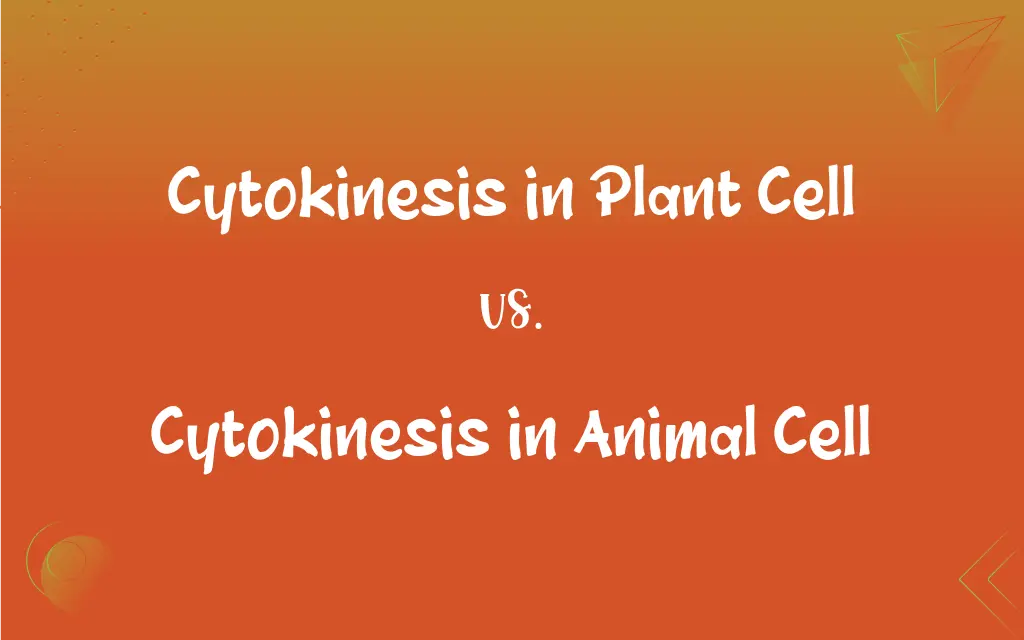Cytokinesis in Plant Cell vs. Cytokinesis in Animal Cell: What's the Difference?
Edited by Aimie Carlson || By Harlon Moss || Updated on October 2, 2023
Cytokinesis in plant cells involves building a cell plate to separate cells, while in animal cells, it involves pinching the cell membrane through a cleavage furrow.

Key Differences
Cytokinesis in plant cells initiates a different mechanism than in animal cells due to the presence of a rigid cell wall. In contrast, animal cells, devoid of such structural constraints, employ a straightforward approach. The rigidity of the plant cell wall necessitates an internal division, whereas the flexibility of the animal cell membrane allows for an external constriction.
The construction of a cell plate is fundamental to cytokinesis in plant cells, gradually developing into a new cell wall to separate the daughter cells. Animal cells diverge in this process, wherein a cleavage furrow is formed that gradually pinches the cell into two. Thus, the plant cell creates a new structure, while the animal cell manipulates its existing one.
The role of vesicles is pivotal in the plant cell cytokinesis as they transport materials to build the dividing cell plate. In contrast, in animal cells, the actin and myosin microfilament ring contracts to create the aforementioned cleavage furrow. Therefore, vesicle involvement is crucial for plant cells, whereas microfilament action is vital in animal cells.
In the realm of cytokinesis in plant cells, the cell plate eventually matures into a new cell wall, ensuring each daughter cell is encased in a protective layer. Contrarily, the cytokinesis in animal cells leaves the daughter cells with no additional protective structure, relying on the original cell membrane. The plant cells generate a new protective layer, whereas animal cells do not.
It is notable that cytokinesis in plant cells does not employ motor proteins in the same way animal cells do. Animal cell cytokinesis uses motor proteins that interact with actin to facilitate the cleavage furrow formation. Hence, in plant cells, motor proteins are less integral to cytokinesis, while in animal cells, they play a pivotal role in the process.
ADVERTISEMENT
Comparison Chart
Mechanism of Division
Builds a cell plate internally to divide the cell.
Forms a cleavage furrow externally to pinch the cell.
Structural Development
Develops a new cell wall from the cell plate.
Relies on the existing cell membrane with no new structure.
Vesicle Involvement
Vesicles transport materials to form the cell plate.
Vesicles are not heavily involved in cleavage formation.
Use of Microfilaments
Microfilaments are not significantly used in division.
Microfilaments (actin, myosin) facilitate division.
Post-Division Protection
Each daughter cell is surrounded by a rigid cell wall.
Daughter cells have only their original cell membrane.
ADVERTISEMENT
Cytokinesis in Plant Cell and Cytokinesis in Animal Cell Definitions
Cytokinesis in Plant Cell
Cytokinesis in plant cells concludes the cell division process post the completion of mitosis.
After mitosis, cytokinesis in plant cell takes the stage to physically separate the two cells.
Cytokinesis in Animal Cell
Cytokinesis in animal cells is characterized by the formation of a cleavage furrow, pinching the cell into two.
The defining feature of cytokinesis in animal cell is the gradual deepening of the cleavage furrow.
Cytokinesis in Plant Cell
Unlike animal cells, cytokinesis in plant cells does not utilize a cleavage furrow.
The absence of a cleavage furrow is characteristic of cytokinesis in plant cell.
Cytokinesis in Animal Cell
Unlike plant cells, no new physical barrier is constructed between the two new cells in animal cell cytokinesis.
Cytokinesis in animal cell leaves the daughter cells with their initial, unaltered cell membranes.
Cytokinesis in Plant Cell
It is a vital process where one parent plant cell divides to form two new cells, ensuring growth and repair.
Cytokinesis in plant cell facilitates not only growth but also repair and regeneration.
Cytokinesis in Animal Cell
It is a crucial phase that ensures the genetic material is neatly parceled into two new animal cells.
Through cytokinesis in animal cell, the cytoplasm is evenly distributed among the daughter cells.
Cytokinesis in Plant Cell
Cytokinesis in plant cells involves the formation of a cell plate that eventually becomes a new cell wall.
The cytokinesis in plant cell ensures that each daughter cell is encased in a fresh, sturdy cell wall.
Cytokinesis in Animal Cell
The process doesn’t create any new cell wall or membrane but utilizes the existing membrane to finalize cell separation.
Cytokinesis in animal cell ensures division without the formation of any additional protective structure.
Cytokinesis in Plant Cell
The process leans heavily on vesicles which ferry components to build the new wall during cytokinesis in plant cells.
Vesicles are integral to cytokinesis in plant cell, contributing to the formation of the cell plate.
Cytokinesis in Animal Cell
Microfilaments, especially actin and myosin, play a crucial role in animal cell cytokinesis.
The role of actin and myosin is pivotal during cytokinesis in animal cell, assisting in furrow formation.
FAQs
What initiates cytokinesis in plant cells?
The initiation is marked by the formation of a cell plate.
What role do microfilaments play in animal cell cytokinesis?
They facilitate the formation and deepening of the cleavage furrow.
Is a new cell wall formed during cytokinesis in plant cells?
Yes, a new cell wall is formed from the cell plate.
Are vesicles crucial in cytokinesis in plant cells?
Yes, vesicles transport materials to form the cell plate.
What happens to the daughter cells post-cytokinesis in plant cells?
They become two separate entities each encased in its own cell wall.
How does cytokinesis in animal cells begin?
It begins with the formation of a cleavage furrow.
Is the mechanism of cytokinesis in plant cells similar to animal cells?
No, they utilize different mechanisms due to structural variations.
Is there any new membrane formation in cytokinesis in animal cells?
No, the existing cell membrane is simply pinched into two.
Why is there no cell plate formation in animal cell cytokinesis?
The flexibility of the animal cell membrane allows for a cleavage furrow instead.
Do plant cells change shape during cytokinesis like animal cells?
No, plant cells largely retain their shape, developing a cell plate internally.
Are daughter cells immediately independent after cytokinesis in animal cells?
Yes, they become two distinct cells each with its own membrane.
Can cytokinesis in plant cells happen without a cell plate?
No, the cell plate is crucial to form the new cell wall.
Is there a change in the volume of the new cells after cytokinesis in animal cells?
No, the total cellular volume is conserved and distributed among daughter cells.
What signals the end of cytokinesis in plant cells?
The maturation of the cell plate into a new cell wall signals its completion.
Does the cytoplasm divide during cytokinesis in plant cells?
Yes, it is evenly distributed between the two new cells.
What ensures equal division of cytoplasm in cytokinesis in animal cells?
The cleavage furrow ensures an equitable division of the cytoplasm.
Is cytokinesis in animal cells dependent on a rigid structure formation like in plant cells?
No, it relies on the flexibility of the existing cell membrane.
What finalizes cytokinesis in animal cells?
The complete pinching in of the cleavage furrow finalizes the process.
Is energy consumption similar in cytokinesis for both plant and animal cells?
No, the mechanisms (cell plate formation and cleavage furrow) have different energy demands and consumptions.
Are the mechanisms of cytokinesis evolutionarily conserved across plant and animal kingdoms?
While the objective (cell division) is conserved, the mechanisms have evolved divergently.
About Author
Written by
Harlon MossHarlon is a seasoned quality moderator and accomplished content writer for Difference Wiki. An alumnus of the prestigious University of California, he earned his degree in Computer Science. Leveraging his academic background, Harlon brings a meticulous and informed perspective to his work, ensuring content accuracy and excellence.
Edited by
Aimie CarlsonAimie Carlson, holding a master's degree in English literature, is a fervent English language enthusiast. She lends her writing talents to Difference Wiki, a prominent website that specializes in comparisons, offering readers insightful analyses that both captivate and inform.































































